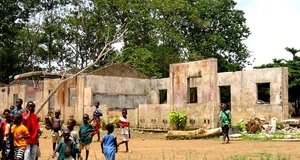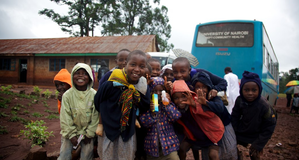Featured Article:The Dead Bodies of the West African Ebola Epidemic: Understanding the Importance of Traditional Burial PracticesDeath and Mourning in West AfricaThe idea of life and death in West Africa is parallel to the anthropological understanding of death as a continual process. In African religions, death does not signify the end of life but the pathway to an afterlife. African philosophy looks at human existence as a dynamic process involving the balance of power between life forces (Mbiti, 1969). There are different levels of life and death depending on the amount of life force within the person. For example, African languages would describe sickness as “living a little,” which means a lower level of life. Any misfortune or weakness, such as illness, diminishes the level of the vital force. Through this analogy, death is not considered to be something that alters the life of an individual but merely something that changes the conditions inside the person and the person can still continue to live in the community with their ancestors (Tempels, 1959). As perceived to be the major communicator between the visible and invisible worlds, death marks a person’s heightened connection to understanding creation. The completion of the correct funeral rituals is essential in African societies to ensure that the dead soul makes a safe passage to the ancestral world and more importantly, doesn’t find its way back to the world of the living (Mbiti, 1969). West African ethnic groups involve themselves in intricate rituals for their mourning and burial ceremonies. Since they believe that death does not end the cycle of life but is a continuation of the life cycle, it is necessary for them to go through many rituals and practices before finally burying their family members. There is extensive ethnographic evidence about the West African belief in the ancestral world, including the belief that ancestors have the power to communicate to the living. The West African theory about death can furthermore be fit into an understanding of death as a rite of passage (van Gannep, 1960). Based on the consideration of the belief in the existence of life after death, West Africans insist on treating the bodies of their dead with the utmost respect. One strong belief that fuels this thought is that the dead can retaliate and even communicate with the living through various means if they are not happy about the treatment of their body (Mbiti, 1969).Many West African ethnic groups perceive death as the beginning of a deeper relationship focused on the idea of creation. Therefore, a complementary rite of passage ritual allows for the communication between the visible living world and the invisible ancestral world. The necessity of a proper mourning and burial is also important for the deceased because without such a ritual, the person will become a ghost and will wander through the border of the invisible and visible worlds in search of a place to rest. Consequently, the funeral rituals are often more for the benefit of the living who need to ensure that they are safe from the ghosts of their deceased family members who have the potential of causing harm to the living. Additionally, there is a strong sense of ambivalence about the issue of death in the West African community that borders on love and respect on one hand and fear and despair for the dead on the other (Piot, 2010). The sense of fear primarily stems from the belief that the dead have impressive powers over the living. Mourning Rituals Before and After BurialThe mourning of the dead person in the community is a profound occasion in West African communities. The mourning process for some groups might take as long as weeks during which the people who knew the deceased person mourn his passing into the afterlife. Normally, the status of the deceased person within the community will dictate the mourning period that is practiced after the death. For instance, if the deceased member of the community was an influential person or a well-respected elderly person, the mourning period might begin a few weeks before the actual funeral (Jindra and Joel, 2013). One ritual that is commonly practiced in Liberia and Guinea is for the immediate family members of the deceased to cover up every reflective object that is in the room with the dead body. The reason behind this ritual is to discourage the ghost of the deceased person, believed to be most attracted to reflective surfaces, from roaming about (Magesa, 1997). Furthermore, the windows and doors to the room are also closed as a sign of respect for the dead. The immediate family will also clear furniture from the room, especially the beds, and the women in the family will sit down in the room wailing and keeping vigil over the dead body. It is very common for people from distant places to arrive to the home of the deceased to console the family and to keep watch over the body. In Liberia, the body of the deceased is washed during the mourning period by an elder relative to maintain respect for the deceased. Then the women in the immediate family and community wrap the body, place it on the ground, and sit with it until the funeral day. Additionally, during these mourning vigils the forehead of the deceased is often touched or kissed by family members as a sign of respect (Magesa, 1997). One strict rule during the mourning period practiced in Liberia is that members of the immediate family should refrain from socializing with other community members. It is considered highly inappropriate if the entire immediate family does not stay with the body of the deceased in their home until the burial. The observation of silence and sorrow are the appropriate emotions displayed among the bereaved family in Liberia (Irish, 1993). Other members of the community, especially the women, will arrive at the home compound of the dead to assist in the preparation of food for the mourners. In Guinea, mourners wear black clothing to symbolize their sorrow for the departure of their beloved one. Another symbolic act during mourning in most West African communities is shaving the head in order to show acceptance of the death. The shaving of the head is symbolic because it represents the concentration of life while growing hair symbolizes the strengthening of life, especially for the bereaved family (Jindra and Joel, 2013). Also, in some communities, the bereaved spouse of the deceased has the obligation of sleeping in either the same room or same bed as the deceased family member as an act of saying goodbye to the deceased (Jindra and Joel, 2013). The mourning period continues on even after the completion of the burial. In West African societies, women who have lost their husbands mourn their spouses for a period of one year during which the woman does not let her hair grow and always has a black scarf tied around her head (Geschiere, 2009). Furthermore, these women are expected to refrain from mingling with men during the mourning period to maintain respect for her husband until his ghost comfortably settles into the world of the dead (Geschiere, 2009). West African children are similarly expected to mourn their parents for a period of three months. Traditionally, in Liberia women wear black clothing when in mourning and the children wear white clothing to show their grief and sorrow over the death of a member of their family (Jindra and Joel, 2013). Burial Traditions for a Safe Passage to the AfterlifeThe most important goal during West African burial rituals is to ensure that the body and soul of the deceased is sent to a comfortable place in the afterlife through appropriate traditions. The burial traditions in West African communities, similar to the mourning traditions, are lengthy and depend on the status, gender, and age of the deceased person. The more influential people in the community as well as elder community members will receive longer burial celebrations than their younger counterparts. Interestingly, West African communities do not perform elaborate burial rituals for people who die young or as infants, although the appropriate traditions are still followed when burying them (Jindra and Joel, 2013). West African religious philosophy dictates that living community members should make the transition after death as smooth as possible through the incorporation of appropriate burial rituals. Failure to do so would result in the deceased returning to the world of the living and terrorizing the community members who had not appeased them during the funeral rites (Goody, 2013). A major ritual in the funeral arrangements and celebrations for a deceased person is the offering of food to the mourners and the bereaved family. It is traditional to make sure that the mourners and other community members who have come to bury the dead are fed well because this shows respect accorded to the deceased (Goody, 2013). When an influential person in the community dies, his extended family is responsible for providing enough food for the mourners for the purposes of paying respect to their deceased loved one. Another tradition commonly observed at West African burial rituals is dancing. The mourners will remove the body from the house on the night preceding the day of the burial and all the mourners will dance around it. Normally, the men will dance around the body of the deceased while the women wail loudly to indicate their sorrow. Men do not regularly wail to express sorrow because this act is understood to be unmanly (Jindra and Joel, 2013). A burial ritual that is observed in Guinea consists of slaughtering a bull and spilling its blood on the burial ground before sprinkling some of the bull’s blood on the immediate bereaved family. The purpose of this ritual is to cleanse the family from attacks of evil spirits and ghosts of the deceased. The blood poured into the burial ground is what will be accompanying the deceased into the world of the dead so that the ghost can rest safely among the ancestral community. Occasionally, the body of the deceased is covered in the hide of the slaughtered animal for the purpose of showing the family’s and community’s affection for the deceased individual (Magesa, 1997). Another common ritual is for the family of the deceased to take all of the belongings of the deceased and place them next to the body at the burial site. These belongings act as an additional accompaniment for the deceased into the afterlife so they will have an easier time continuing with their normal activities. If the community believes that another member of the community killed the deceased through an evil act, the body will be buried with weapons such as axes, knives, and machetes so that the dead person can avenge his death (Magesa, 1997). In West African communities, children and women are not permitted to visit the graveyard during the funeral because they are considered to be inferior within the community, which means they might cause bad luck during the funeral rituals. Therefore, it is the men of the community that are directly involved in the funeral rites (Jindra and Joel, 2013). Many communities in West Africa practice the tradition of “home bringing” during which the community gathers at the graveyard and slaughters a bull about one month after the burial of the body. This slaughtering ceremony serves to show that the bereaved family is still grieving over the death of their loved one. Following the slaughtering ceremony, the bereaved family speaks to old ancestors, including their recently deceased relative, and asks them to allow the family to continue the rest of their lives in peace. The common belief is that before the bereaved family conducts the “home bringing” ceremony the spirit of the dead person is still hovering around waiting to find a place to rest (Goody, 2013). The function of the “home bringing” ceremony allows the spirit of the dead family member to return home with its family so that it can act as their ancestor and protect them from harm.Continued on Next Page » Suggested Reading from Inquiries Journal
Inquiries Journal provides undergraduate and graduate students around the world a platform for the wide dissemination of academic work over a range of core disciplines. Representing the work of students from hundreds of institutions around the globe, Inquiries Journal's large database of academic articles is completely free. Learn more | Blog | Submit Latest in Anthropology |
















